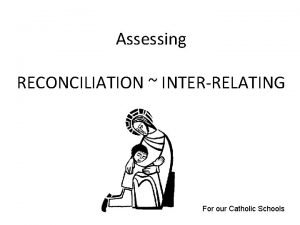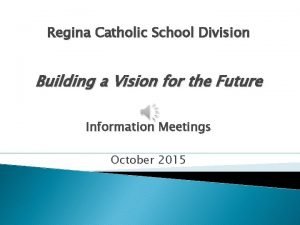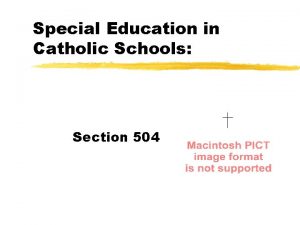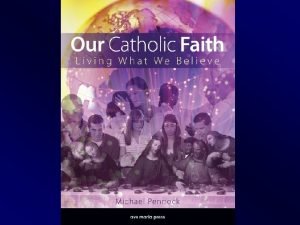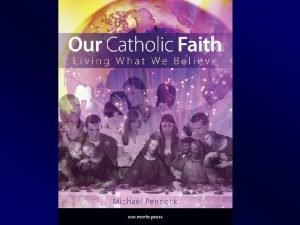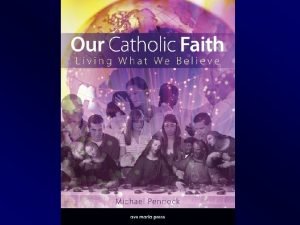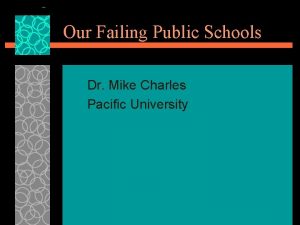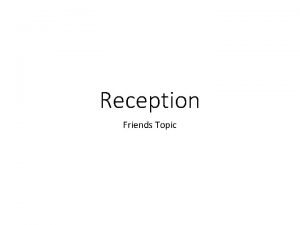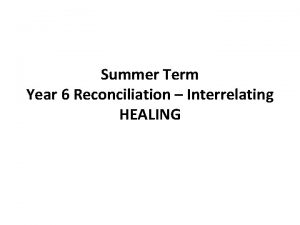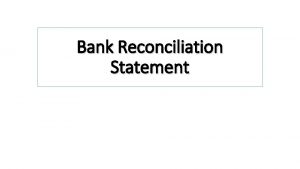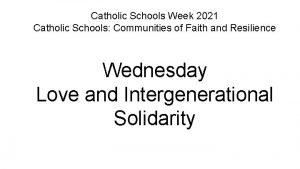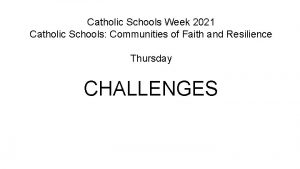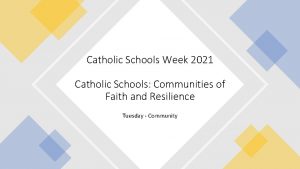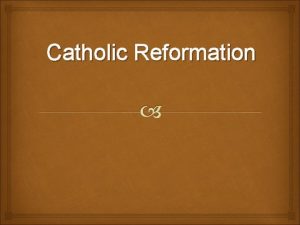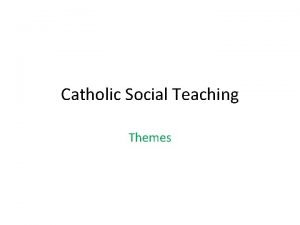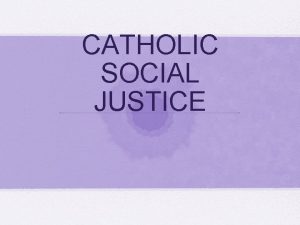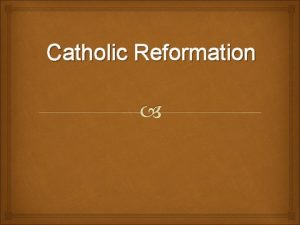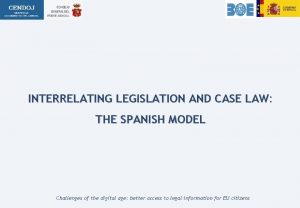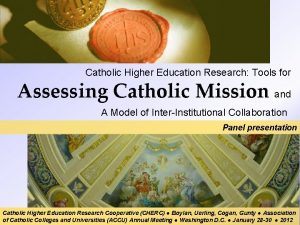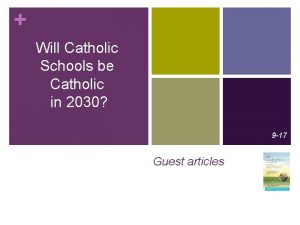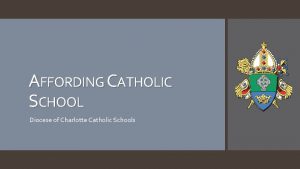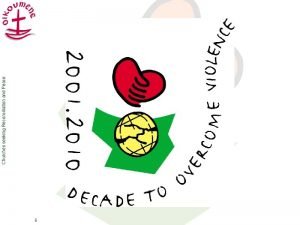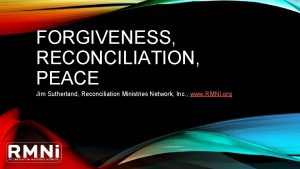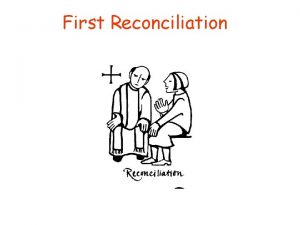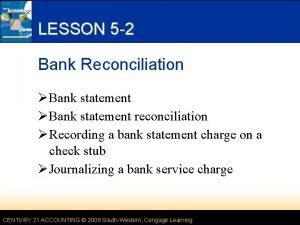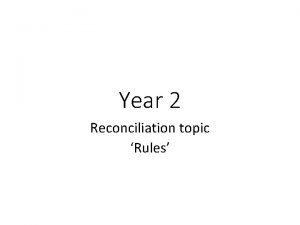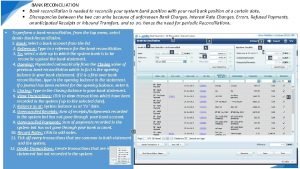Assessing RECONCILIATION INTERRELATING For our Catholic Schools Assessing

























- Slides: 25

Assessing RECONCILIATION ~ INTER-RELATING For our Catholic Schools

Assessing RECONCILIATION ~ INTER-RELATING • This term, the formally assessed theme is the SACRAMENTAL THEME – RECONCILIATION • We will be formally assessing AT 1 (ii). The children may be informally assessed against the other strands. • Each year group will assess from an activity taken from or based on a Learning Focus in Reveal. • The activities are listed over the next few slides. • When planning please leave this task out. • Please teach all of Explore, Reveal (but not the task you will use for the formal assessment) and following Remember please formally assess. • This enables the children to have had opportunity to work through the topic in full to inform their assessment.

Assessing RECONCILIATION ~ INTER-RELATING N. B. To help you, please make use of : • the Sacramental notes on the Come and See Website • the background notes provided • the topic webs given.

ATTAINMENT TARGET 1 : Learning about Religion (i) beliefs, teachings and sources CHURCH THEME ii) celebration and ritual SACRAMENTAL THEME iii) social and moral practices and way of life AT 2 : Learning from Religion i) engagement with own and others’ beliefs and values ii) engagement with questions of meaning and purpose CHRISTIAN LIVING THEME 1 Recognise some religious stories Recognise some religious signs and symbols and use some religious words and phrases Recognise that people because of their religion act in a particular way Talk about their own experiences and feelings Say what they wonder about 2 Retell some special stories about religious events and people Use religious words and phrases to describe some religious actions and symbols Describe some ways in which religion is lived out by believers Ask and respond to questions about their own and others’ experiences and feelings Ask questions about what they and others wonder about and realise that some of these questions are difficult to answer 3 Make links between religious stories and beliefs Use a developing religious vocabulary to give reasons for religious actions and symbols Give reasons for certain actions by believers Make links to show feelings and beliefs affect their behaviour and that of others Compare their own and other people’s ideas about questions that are difficult to answer 4 Describe and show understanding of religious sources, beliefs, ideas, feelings and experiences; making links between them Use religious terms to show an understanding of different liturgies Show understanding of how religious belief shapes life Show an understanding of how own and others’ decisions are informed by beliefs and values Engage with and respond to questions of life in the light of religious teaching 5 Identify sources of religious belief and explain how distinctive religious beliefs arise Describe and explain the meaning and purpose of a variety of forms of worship Identify similarities and differences between peoples’ responses to social and moral issues because of their beliefs Explain what beliefs and values inspire and influence them and others Demonstrate how religious beliefs and teaching give some explanation of the purpose and meaning of human life

Formal Assessment Summer 2016 Reconciliation ~ Inter-relating theme Celebration and Ritual Early Years: Reception Focus 2 p 164, Continuous Provision Activity 1 (adapted). ‘Using the role play area encourage children to talk about how they feel when things go wrong and how they make up as friends. Invite pupils to talk about the pictures from God’s Story 2 p 50. Ask what the children in the pictures can say or do to make things better. ’ Towards L 1

Formal Assessment Summer 2016 Reconciliation ~ Inter-relating theme Celebration and Ritual Early Years: Reception Focus 2 p 164, Continuous Provision Activity 1 (adapted). ‘Add speech/thought bubbles to the pictures. Invite pupils to write or talk about using annotation, what the characters will say and do to make it better. ’ Within L 1

ATTAINMENT TARGET 1 : Learning about Religion ii) celebration and ritual SACRAMENTAL THEME Recognise some religious signs and symbols and use some religious words and phrases Towards L 1, the children may be able to use certain words / phrases e. g. Love, friend, happy, sad, rule, make up, kind, loving, gentle and sorry. Within L 1, the children will be able to recognise words, action and phrases related to asking for, and receiving forgiveness. Photographs of the activities are a good way of recording evidence

Formal Assessment Summer 2016 Reconciliation ~ Inter-relating theme Celebration and Ritual Year 1: Learning Focus 6, p 171, Question 4 Using Church’s Story 2 (p 15) to prompt discussion and ideas, invite the pupils to: ‘Talk about and label the picture with the appropriate words, phrases and actions recognising what is happening in the picture. ’ Level 1

Formal Assessment Summer 2016 Reconciliation ~ Inter-relating theme Celebration and Ritual Year 1: Learning Focus 6, p 171, Question 4 Using Church’s Story 2 (p 15) to prompt discussion and ideas, invite the pupils to: ‘Write or scribe sentences / words to accompany the picture, describing what is happening. ’ Level 2

ATTAINMENT TARGET 1 : Learning about Religion ii) celebration and ritual SACRAMENTAL THEME Recognise some religious signs and symbols and use some religious words and phrases Use religious words and phrases to describe some religious actions and symbols The children at L 1 should recognise some religious actions and use some religious words and phrases related to reconciling with one another – sign of peace, ‘Peace be with You’, forgive, new start, love etc. To achieve L 2, the child needs to use religious words and phrases to describe actions related to reconciling with one another – pupils may relate this to the Mass, Collective Worship or through other liturgies within the school day.

Year 2: Based on Learning Focus 5 p 169, Activity 2 ‘Using Church’s Story 2, page 48, invite the pupils to use some religious words and phrases to describe what is taking place within the picture and what they know about the Sacrament of Reconciliation. ’ Level 2

Year 2: Based on Learning Focus 5 p 169, Activity 2 At L 1, the pupils may label the pictures to show they recognise some religious actions and can use religious words and phrases (At L 3, the pupils can describe what happens in the Sacrament of Reconciliation and give the reasons for the words and actions used. ) N. B. Y 2 pupils are not expected to achieve L 3

ATTAINMENT TARGET 1 : Learning about Religion ii) celebration and ritual SACRAMENTAL THEME Recognise some religious signs and symbols and use some religious words and phrases To achieve Level 1, the pupil has been able to recognise and use some of the words and phrases – sorry, priest, right, wrong, sign of cross, forgive etc. Use religious words and phrases to describe some religious actions and symbols To achieve Level 2, the pupil has been able to describe what is happening within the picture, making reference to some of the actions, symbols, words and phrases involved – forgive, reconciliation, conscience, prayer, sign of cross, sorry, priest etc. Use a developing religious vocabulary to give reasons for religious actions and symbols (To achieve Level 3, the pupil would have to describe and give reasons for the religious actions and symbols within the Sacrament of Reconciliation. )

Year 3: Based on Learning Focus 5 p 179, Activity 1 ‘Using Church’s Story 3 p 66 -67 etc. , invite the children to design a Reconciliation Booklet (given the appropriate headings) which uses religious words and phrases to describe the actions and symbols within the Sacrament of Reconciliation. ’ Level 2 ‘Give reasons for these actions and symbols’ Level 3

Stages of Reconciliation • Introduction – what is the sacrament of reconciliation? • Examination of conscience • Confessing what we have done wrong • Penance • Act of sorrow • Forgiveness and absolution • Go forth to do the penance given by the priest

ATTAINMENT TARGET 1 : Learning about Religion ii) celebration and ritual SACRAMENTAL THEME Recognise some religious signs and symbols and use some religious words and phrases Use religious words and phrases to describe some religious actions and symbols Use a developing religious vocabulary to give reasons for religious actions and symbols The children at L 2 should use religious words and phrases to describe some of the actions and symbols used within the Sacrament of Reconciliation. To achieve L 3, the pupil needs to give reasons for these actions and symbols.

Year 4: Based on Learning Focus 4 p 192, Activity 1. Provide each child with a planner. ‘Invite them to choose appropriate songs, readings, prayers, responses, scripture etc. that would be suitable for a class service of Reconciliation (not the Sacrament of Reconciliation). ’ They should use religious words and phrases to describe their liturgy giving reasons why symbols, actions etc. are chosen. They can be told to include at least an examination of conscience, a penitential rite and act of contrition (can be their own) as part of their liturgy. ’ Level 3

Date: Name: Gather Word Response to the Word – Prayer/Symbolic Action Go Forth Reason for my choice:

ATTAINMENT TARGET 1 : Learning about Religion ii) celebration and ritual SACRAMENTAL THEME N. B. For this task, the outcome will need to be levelled accordingly – see below: Recognise some religious signs and symbols and use some religious words and phrases Use religious words and phrases to describe some religious actions and symbols At Level 2, the children will just use religious words and phrases to describe religious actions and symbols related to a Reconciliation liturgy (no/insufficient reasons given). Use a developing religious vocabulary to give reasons for religious actions and symbols The children, at Level 3, should be able to use religious words and phrases to give (suitable) reasons for the different actions and symbols used in a Reconciliation liturgy. Use religious terms to show an understanding of different liturgies To achieve Level 4, the child would have to demonstrate a clear understanding of the structure of a Reconciliation liturgy and all the elements involved within reconciliation with clear explanation and considerable detail. (– not expected in Year 4)

Year 5: Based on Learning Focus 6 p 190. Refer to Church’s Story 3 p 66 -67, the background and sacramental notes available. ‘Design a leaflet for a friend who is not a Catholic describing what happens during the Sacrament of Reconciliation and giving reasons for the words and actions used. ’ Level 3

Year 5: Based on Learning Focus 6 p 190, Activity 1 ‘Design a leaflet for a friend who is not a Catholic to understand the importance of the Sacrament of Reconciliation, describing and giving reasons for what happens during the rite. Make links to Scripture showing what Catholics believe and how they should act. Level 4

ii) celebration and ritual SACRAMENTAL THEME Recognise some religious signs and symbols and use some religious words and phrases Use religious words and phrases to describe some religious actions and symbols Use a developing religious vocabulary to give reasons for religious actions and symbols Use religious terms to show an understanding of different liturgies At L 2, the child will use religious words and phrases to describe what happens in the Sacrament of Reconciliation. At L 3, the child will use religious words and phrases to give reasons for the religious actions and symbols used in the Sacrament of Reconciliation At L 4, the child will show an understanding of the Sacrament of Reconciliation giving reasons for the actions and symbols used and making links to scripture, what Catholics believe and how they should act.

Year 6: Based on Learning Focus 5, p 210, Activity 1 (Refer to Background notes, Sacramental notes and topic web). ‘Design a leaflet to help someone to understand the importance, for Catholics, of the Sacrament of the Anointing of the Sick. Describe and give reasons for what happens during the rite. Make links with Scripture, what Catholics believe and how they should Level 4 act. ’

Scripture Mark 6; 13 – Anointed with oil James 5: 14 -15 – Praying for the sick Matthew 9: 18 -26 – Jairus’ daughter Prayers/Tradition Lighting of candles Parish Sick List Prayers for the sick Experiences, feelings and ideas How do you think the sick person is feeling at this time? What would bring comfort? How might family members feel? How would you feel? Sacraments The Sacraments of the Sick/Reconciliation (Healing) Holy Communion (Viaticum) Links with Baptism - born with Christ The Sacrament of the Anointing of the Sick Art/Images/Artefacts Holy Oils (Olive) Water Pictures in Church Story 3 pgs 68 - 71 Come and See Website pictures and powerpoint Christian Beliefs Faith in God’s loving mercy Belief in the healing and strengthening power of the Holy Spirit Healing of mind and spirit Hymns Lay your hands Come to the Water Be still and know I am God Oh God you search me and you know me. Christian Life; Beliefs and Values Unity, Dignity, Hope, Love Care and concern for the poor and needy All life is precious The “Body” of Christ Eternal Life Compassion

ii) celebration and ritual SACRAMENTAL THEME Recognise some religious signs and symbols and use some religious words and phrases Use religious words and phrases to describe some religious actions and symbols At L 2, the child will use religious words and phrases to describe what happens in the Sacrament of the Anointing of the Sick. Use a developing religious vocabulary to give reasons for religious actions and symbols At L 3, the child will use religious words and phrases to give reasons for the religious actions and symbols used in the Sacrament of the Anointing of the Sick. Use religious terms to show an understanding of different liturgies Describe and explain the meaning and purpose of a variety of forms of worship At L 4, the child will show an understanding of the Sacrament of the Anointing of the Sick, giving reasons for the action and symbols used and making links with Scripture, what Catholics believe and how they should act. (At L 5, the child would need to identify, describe and explain the meaning and purpose of the Sacrament of the Anointing of the Sick accurately and in great detail showing how and how Catholics respond to the Sacrament according to their beliefs. N. B. Level 5 is not expected in Year 6)
 Reconciliation definition catholic
Reconciliation definition catholic St gabriel school regina
St gabriel school regina 504 plan catholic schools
504 plan catholic schools Powerschool login huntsville city schools
Powerschool login huntsville city schools Reach safety target
Reach safety target Our catholic faith living what we believe
Our catholic faith living what we believe Our catholic faith living what we believe answers
Our catholic faith living what we believe answers Our catholic faith living what we believe
Our catholic faith living what we believe Our lady queen of peace catholic primary school
Our lady queen of peace catholic primary school Our failing schools enough is enough
Our failing schools enough is enough Our failing schools enough is enough summary
Our failing schools enough is enough summary Our awareness of ourselves and our environment
Our awareness of ourselves and our environment Our census our future
Our census our future Awareness of ourselves and our environment is
Awareness of ourselves and our environment is Our life is what our thoughts make it
Our life is what our thoughts make it God our father christ our brother
God our father christ our brother Bernadette farrell christ, be our light
Bernadette farrell christ, be our light Who is the poet of the poem money madness
Who is the poet of the poem money madness Our future is in our hands quotes
Our future is in our hands quotes We bow our hearts we bend our knees
We bow our hearts we bend our knees Our life is what our thoughts make it
Our life is what our thoughts make it Awareness of ourselves and our environment is:
Awareness of ourselves and our environment is: Thinking affects our language which then affects our
Thinking affects our language which then affects our Our awareness of ourselves and our environment
Our awareness of ourselves and our environment Our census our future
Our census our future En lathund för arbete med kontinuitetshantering
En lathund för arbete med kontinuitetshantering
